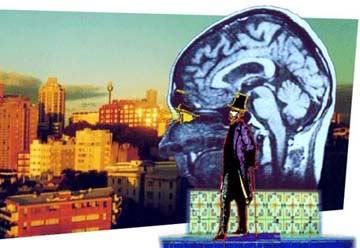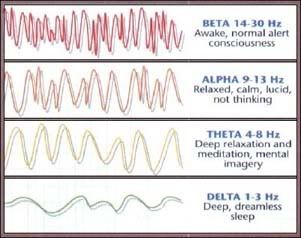
One of the most interesting and notorious questions in the field of neuroscience is "what is consciousness?" The question itself begs a definition of consciousness, as debates over the subject can revolve around syntax alone.
Dictionary.com defines it as: "...awareness of one's own existence, sensations, thoughts, surroundings, etc."
In the colloquial sense, people often mean being aware of their own thought processes, or "thinking about thinking" when they say they are conscious. When people say "I just did it without thinking," they usually mean that they weren’t conscious of their thoughts at the time. For example, of course I was thinking, when I locked myself out of the house, I’m thinking all of the time, but some of my thought processes are just not conscious (and certainly not at that fumbling moment!).
This is similar to Freud’s definition of consciousness. The processes in our mind which occur "without our awareness" are referred to as subconscious thought, while those that have our awareness (being able to "think about thinking") are considered conscious. For this article, I would like to stick with the psychological and colloquial meaning of consciousness: the ability to "think about thinking."
 Most of the brain does not hold the internal monologue that many of us perceive as consciousness. The constant "chatter" of thought over every detail would be too overwhelming. Rather, many of our thoughts go without saying; there is simply too much going on in the world to convey it all at once in the talkative regions of our cerebral cortex we call our conscious mind. (Imagination, too can be considered an internal monologue, just of the nonverbal variety)
Most of the brain does not hold the internal monologue that many of us perceive as consciousness. The constant "chatter" of thought over every detail would be too overwhelming. Rather, many of our thoughts go without saying; there is simply too much going on in the world to convey it all at once in the talkative regions of our cerebral cortex we call our conscious mind. (Imagination, too can be considered an internal monologue, just of the nonverbal variety)Among the brain functions that we readily consider to be unconscious (or subconscious) include the reflexes and autonomic functions that keep us safe and alive. These functions sometimes by-pass the cerebral cortex completely, so it is easy to consider them "unconscious;" after all, they reside primarily in more primitive regions of our central nervous system.
Harder to grasp is the realization that there are also thoughts in our cerebral cortex being produced constantly without our awareness. Being the part of the brain where intellect comes from, it is hard to imagine the cerebral cortex as largely subconscious, but those regions responsible for conscious thoughts are relatively few.
One of my favorite examples of conscious versus subconscious thought processing in the cerebral cortex comes from studies of the human visual system. The condition of “blind sight” arises when patients cannot name any object before them and have no conscious sensation of sight, yet their reflexes to “seen” objects (such as a ball coming toward their head) and their ability to reach out, grab, and mechanically maneuver “seen” objects remains intact.
A common test for the condition of blind sight as described by Dr. Ramachandran in his book Phantoms in the Brain is to ask the patient to mail a letter. Patients will often become exasperated, saying they see no letter, yet they can reach out and grab the object without the aid of any auditory or tactile clues. They are then able to turn the letter at the correct angle and insert it into a mail slot without ever having touched the slot!
 One needs many parts of the brain functioning to see correctly, and blind sight often occurs in individuals who either have a portion their temporal lobe that deciphers what one is seeing destroyed or in individuals who have parts of their visual cortex damaged. According to a study by Stoerig and Cowey, even in monkeys where the entire visual cortex was experimentally removed blind sight was still found to occur. This means that seeing is not entirely a conscious act, rather only understanding what it is you’re looking at involves the conscious mind. Below is a diagram of the portions of the brain required for full conscious interpretation of a visual object:
One needs many parts of the brain functioning to see correctly, and blind sight often occurs in individuals who either have a portion their temporal lobe that deciphers what one is seeing destroyed or in individuals who have parts of their visual cortex damaged. According to a study by Stoerig and Cowey, even in monkeys where the entire visual cortex was experimentally removed blind sight was still found to occur. This means that seeing is not entirely a conscious act, rather only understanding what it is you’re looking at involves the conscious mind. Below is a diagram of the portions of the brain required for full conscious interpretation of a visual object:
Regions of the parietal lobe where the physical location of seen objects in space is interpreted are not shown as they are considered largely unconscious. The visual cortex is needed to make a conscious interpretation of a visual object, but is not necessarily the conscious element. It seems that the inferior temporal cortex and lateral prefrontal cortex are where consciousness resides with regards to sight, as without these regions an individual cannot make heads or tails of what a seen object is.
A good example of the same idea is the way in which my older brother, Tony, approaches math versus my way. For me, math is something I can do but not without effort. I rely heavily upon my conscious mind--likely the highly organized systematic methods of my temporal lobe--to perform mathematical functions as I walk myself through the process step by step. My older brother, on the other hand, thinks math is a breeze. He flew through calculus in high school like it was nothing and scored a perfect on the math portion of the SATs. As it turns out though, I am possibly the better math teacher because I can explain the processes involved in completing a problem as I am very consciously aware of the steps I go through. Tony has a difficult time explaining math though, as it is something he "just does," like a painter just has a knack for putting form to paper.
I theorize that when people are more skilled in areas like math (or for me, my intrinsic area that I can’t explain is art), they are utilizing parts of their mind that perform these functions subconsciously, without the need for wasting time and brain space on internal monologue.
 So how can we maximize the potential of our subconscious and bring it to surface in our conscious mind? According to studies using EEGs to record brain wave activity, the prime time for surfacing of these subconscious thoughts is during trance, meditation, right before sleep, or right after. These are times when the brain produces alpha waves; a characteristic pattern made when the subconscious, unconscious, and conscious patterns are all high and seem to be communicating best with each other.
So how can we maximize the potential of our subconscious and bring it to surface in our conscious mind? According to studies using EEGs to record brain wave activity, the prime time for surfacing of these subconscious thoughts is during trance, meditation, right before sleep, or right after. These are times when the brain produces alpha waves; a characteristic pattern made when the subconscious, unconscious, and conscious patterns are all high and seem to be communicating best with each other.This may account for why common wisdom tells us to “sleep on it,” before you make a big decision. There are often observations you’ve made and elements to consider regarding a decision that you already technically “know,” but they must be given time to surface into the conscious mind. Sometimes, giving your chatty conscious mind a rest seems to do the trick. According to Dijksterhuis in a study publish in Science, more satisfying decisions were made by subjects who did not undergo conscious deliberation on highly detailed decisions. The subconscious appears to be the real genius in these instances, as it can deliver the best results while the conscious mind takes a rain check.
Sources:
Ap Dijksterhuis et al. "On Making the Right Choice: The Deliberation-Without-Attention Effect." Science. 2006
V.S. Ramachandran. Phantoms in the Brain. 1998
http://www.crossroadsinstitute.org/eeg.html
http://brain.oxfordjournals.org/cgi/content/abstract/120/3/535
Images:
http://www.altered-states.net/barry/newsletter193/index.htm
http://www.web-us.com/brain/PhysiologyOrdinaryConsciousness.htm
http://pr.caltech.edu/periodicals/eands/articles/LXVII2/koch.html


3 Comments:
I really enjoyed that. Thanks.
By Anonymous, at 2:16 PM
Anonymous, at 2:16 PM
Something I thought about while reading this was that I tend to try to make things intrinsic-- with math and chemistry I don't try to be rational, I try to understand fundamentally the relationships between the formulas while incorporating every new piece of information to my abstract concept of the world around me. In the end, what it means for me is a horrific lag phase in my learning curve, but when finally and truly understand something I tend to do it better than my peers because I'm able to extrapolate the results of this new-found internalization into every nook and cranny of its related fields of study.
~Sam
By Anonymous, at 2:22 PM
Anonymous, at 2:22 PM
"Most of the brain does not hold the internal monologue that many of us perceive as consciousness."
LIES!! Have you watched Scrubs? Perfect example of internal monologues. I win. :)
By Anonymous, at 3:15 AM
Anonymous, at 3:15 AM
Post a Comment
<< Home